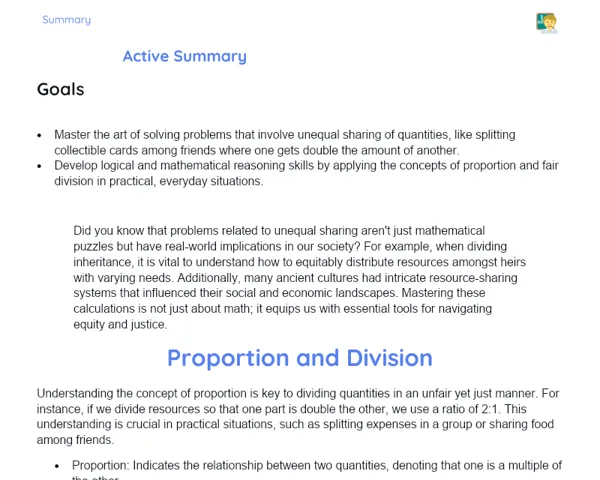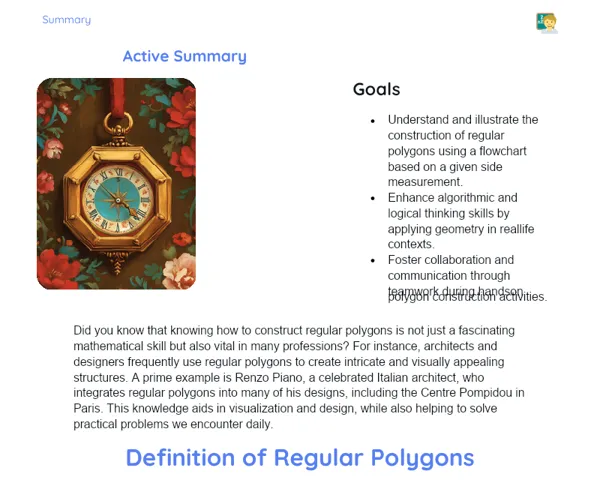Summary Tradisional | Triangles: Classification by Sides
Contextualization
Triangles are essential geometric shapes with three sides and three vertices, formed by connecting three line segments. They are not just theoretical concepts but have significant applications in practical fields like engineering and architecture. Understanding how to classify triangles is crucial for tackling complex problems and employing these shapes in real-life scenarios.
When classifying triangles according to their sides, we typically identify them as equilateral, isosceles, or scalene. An equilateral triangle has all sides equal, an isosceles triangle has two sides that are the same and one that is different, while a scalene triangle has all sides of different lengths. Moreover, for three segments to successfully form a triangle, the sum of the lengths of any two sides must exceed that of the third side. Grasping this concept is essential to ensure the stability and strength of structures in construction and other practical contexts.
To Remember!
Classification of Triangles by Sides
Triangles can be categorized into three primary types based on the lengths of their sides: equilateral, isosceles, and scalene. This categorization is key to understanding the geometric properties of triangles and their applications in the real world. Knowing the distinctions among these types aids in solving geometric problems with more accuracy, and applying these concepts in fields like construction and design.
An equilateral triangle has all three sides equal, which also means that all its internal angles are equal, each measuring 60 degrees. This symmetry renders the equilateral triangle a particularly stable figure and is often employed in designs necessitating uniformity and balance.
An isosceles triangle features two equal sides and one differing side, with the angles opposite the equal sides also being equal. This property adds a certain symmetry to the figure, making isosceles triangles commonplace in various practical applications like rooftops and other architectural structures.
A scalene triangle has all sides of different lengths, leading to all internal angles being different as well. This type of triangle is the most common and can be observed in irregular shapes in both nature and human constructions, providing flexibility for different practical uses.
-
Equilateral triangle: all sides equal; internal angles equal to 60 degrees.
-
Isosceles triangle: two sides equal; one different side; angles opposite the equal sides also equal.
-
Scalene triangle: all sides and internal angles different.
Equilateral Triangle
An equilateral triangle is characterized by equal lengths for all three sides. The internal angles are also equal, each measuring 60 degrees. This symmetry renders the equilateral triangle as a distinctive figure in terms of balance and structural sturdiness.
In practice, equilateral triangles are often employed in situations requiring uniformity and balanced force distribution. For instance, in civil engineering, equilateral triangular structures are utilized to ensure the stability of bridges and buildings. The equal sides and angles allow forces to be evenly spread across the whole structure.
Additionally, equilateral triangles are favored in design and art due to their symmetrical nature, creating a sense of visual harmony that is commonly seen in decorative patterns and artistic compositions.
-
All sides are equal.
-
All internal angles measure 60 degrees.
-
Used in civil engineering to ensure stability.
-
Popular in design and art for its symmetrical aesthetic.
Isosceles Triangle
The isosceles triangle is defined by having two sides of equal length and one differing side. The angles opposite the equal sides are also equal, offering a degree of symmetry to the shape. This feature makes isosceles triangles highly useful in various applications.
In architecture, isosceles triangles frequently find use in roofs and other structures requiring a stable base and a central point of elevation. The symmetry in angles and sides ensures a balanced distribution of loads, enhancing stability in the construction.
Moreover, equal angles in isosceles triangles assist in solving geometric problems. Identifying these triangles in more complex figures can simplify calculations for unknown angles and sides.
-
Two sides equal; one different.
-
Angles opposite the equal sides are equal.
-
Commonly used in roofs and other architectural structures.
-
Assists in simplifying complex geometric challenges.
Scalene Triangle
A scalene triangle is noted for having all three sides of varying lengths, leading to all internal angles being different. This lack of symmetry makes the scalene triangle a versatile geometrical shape used in numerous practical applications.
In engineering, scalene triangles are often incorporated into irregularly-shaped structures, like certain types of bridges and mechanical components. The diversity of angles and lengths allows for design flexibility that can be tailored to specific needs.
Moreover, understanding scalene triangles is crucial when addressing complex geometric problems. Identifying and classifying scalene triangles within complicated figures can assist in uncovering unknown measurements and gain a better understanding of the overall structure.
-
All sides differ in length.
-
All internal angles are different.
-
Utilized in structures requiring irregular shapes.
-
Essential for resolving intricate geometric issues.
Conditions for the Existence of a Triangle
To form a triangle from three line segments, it is necessary that the sum of the lengths of any two sides exceeds the length of the third side. This essential condition is known as the triangle inequality.
For example, take segments measuring 3 cm, 4 cm, and 5 cm. To determine if these can form a triangle, we verify the following: 3 + 4 > 5, 3 + 5 > 4, and 4 + 5 > 3. All these conditions hold true, hence these segments can indeed form a triangle.
Conversely, for segments measuring 1 cm, 2 cm, and 4 cm, the sum of 1 + 2 is not greater than 4, indicating these cannot form a triangle. Such verification is crucial in practical fields like engineering and architecture, ensuring that shapes and structures are viable and stable.
-
The sum of two sides must exceed the third side.
-
Fundamental for confirming the existence of a triangle.
-
Crucial in engineering and architectural applications.
-
Aids in assessing the viability and stability of structures.
Key Terms
-
Equilateral Triangle: Triangle with equal sides and angles.
-
Isosceles Triangle: Triangle with two equal sides and one different; angles opposite the equal sides are equal.
-
Scalene Triangle: Triangle with all sides and internal angles differing.
-
Condition for the Existence of a Triangle: The sum of the lengths of any two sides must exceed the length of the third side.
Important Conclusions
In today's session, we delved into the classification of triangles according to their sides, identifying the types as equilateral, isosceles, and scalene. We learned that an equilateral triangle has all sides equal, an isosceles triangle features two equal sides and one differing side, while a scalene triangle has sides of varying lengths. Additionally, we covered the critical condition for triangle formation, emphasizing that the summation of the lengths of any two sides must exceed that of the third side.
These concepts serve as a solid foundation, not only for solving geometric problems but also for practical use in engineering and architecture. The inherent structural stability provided by triangles is paramount for creating safe and resilient constructions. Consequently, the lessons learned today are highly applicable across various fields and real-world scenarios.
We encourage students to keep exploring this topic, as a thorough comprehension of triangles and their properties can lead to numerous academic and professional avenues. Continuous practice and application of these concepts in diverse contexts will help reinforce knowledge and develop critical skills in geometry.
Study Tips
-
Review the concepts of triangle classification by sides and try spotting examples in your daily surroundings.
-
Practice solving geometric problems involving triangles, checking conditions for existence and classifying them appropriately.
-
Investigate the practical uses of triangles in engineering and architecture, analyzing how their properties contribute to structural integrity.



